Ready to turn your balcony into a mini vegetable paradise? A balcony vegetable garden lets you grow fresh produce right at home, no backyard needed. With a few pots and some sunlight, you can enjoy the satisfaction of harvesting your own veggies, all while adding a splash of green to your space!
Seasonal Planting Schedule for Continuous Harvest
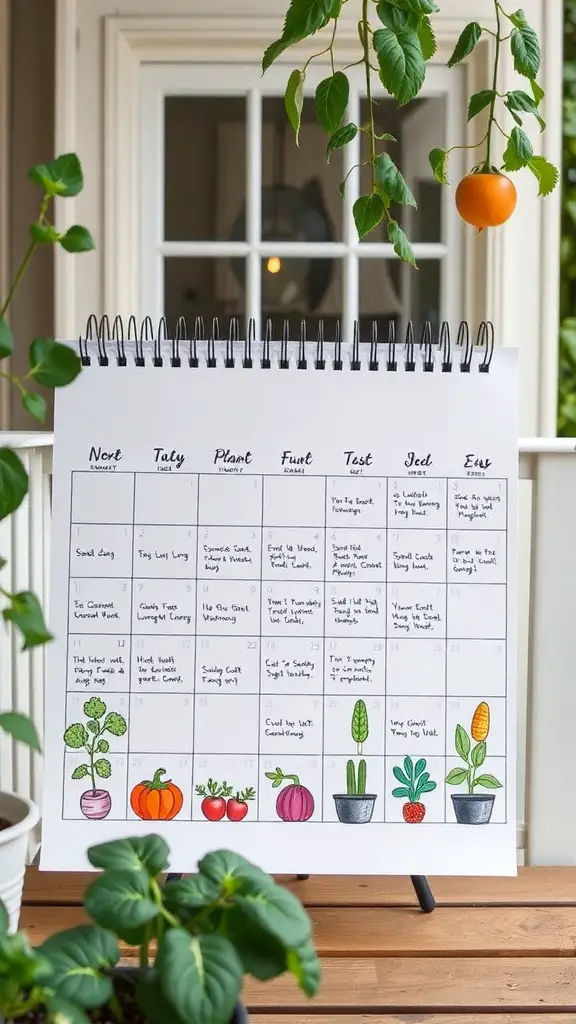
In a balcony vegetable garden, timing is everything. The image shows a colorful planting calendar, which is a great tool for planning your garden throughout the seasons. Each month is filled with notes on what to plant, ensuring you have fresh produce all year round.
Starting with spring, you can plant quick-growing vegetables like radishes and lettuce. As the weather warms, transition to tomatoes and peppers. The calendar helps you visualize when to start seeds indoors and when to transplant them outside.
Summer is perfect for herbs and cucumbers. The calendar reminds you to keep harvesting to encourage new growth. As fall approaches, consider planting kale and carrots, which thrive in cooler temperatures. This way, your balcony remains productive even as the seasons change.
Using a planting schedule like this one keeps your garden organized and ensures you enjoy a continuous harvest. It’s a simple way to make the most of your space and time.
Watering Strategies for Balcony Vegetables
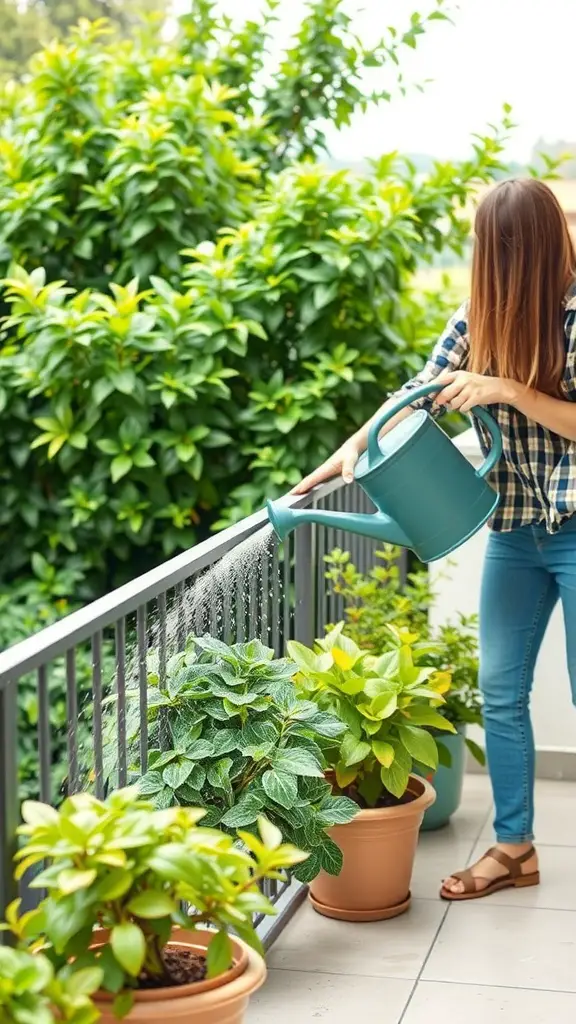
Watering your balcony vegetable garden is key to healthy plants. In the image, a person is watering vibrant green plants in pots, showing how easy it can be to care for your veggies.
Using a watering can, like the one shown, allows you to control the amount of water each plant gets. This is especially useful for balcony gardens where space is limited. Aim to water early in the morning or late in the evening to avoid evaporation.
Check the soil moisture regularly. If the top inch feels dry, it’s time to water. Overwatering can be just as harmful as underwatering, so find a balance that works for your plants.
Consider using self-watering pots if you’re busy. These pots have a reservoir that keeps the soil moist for longer periods. This can help reduce the frequency of watering while ensuring your plants stay hydrated.
Soil and Nutrient Requirements for Balcony Gardens

Creating a balcony vegetable garden starts with the right soil. The image shows a mix of rich, dark soil combined with small stones and chunks. This combination is ideal for growing vegetables in containers.
Good soil provides essential nutrients for your plants. It should be well-draining to prevent water from pooling, which can harm roots. The mix in the image suggests a balance of organic matter and minerals, perfect for healthy growth.
Adding compost can boost nutrient levels. It enriches the soil and helps retain moisture. You can also consider using slow-release fertilizers to keep your plants fed throughout the growing season. Regularly checking the soil’s pH can help ensure it stays within the ideal range for vegetables.
Remember, the right soil is the foundation of a thriving balcony garden. With the right mix, your plants will flourish, giving you fresh veggies right at your doorstep!
Container Selection for Healthy Plant Growth
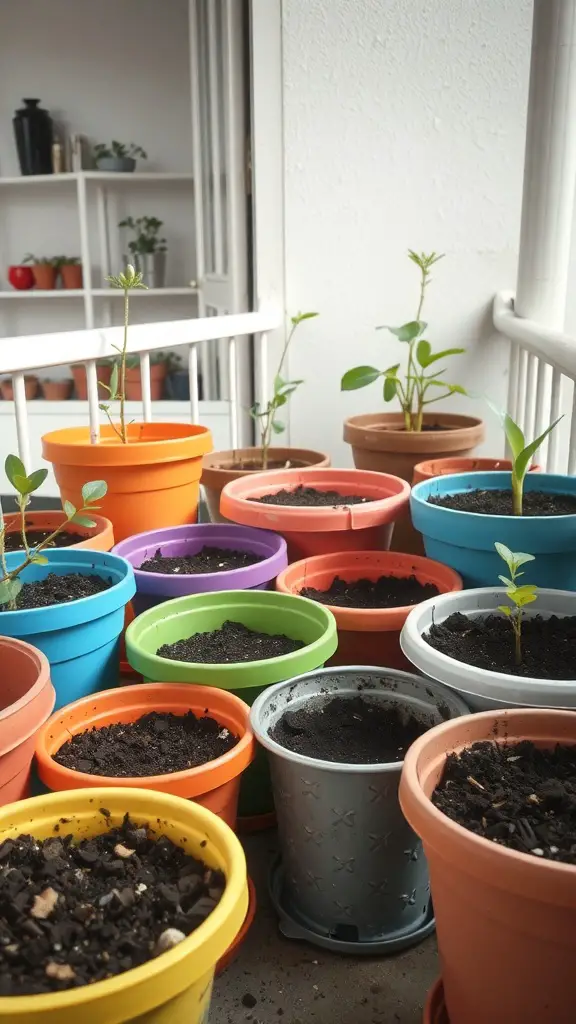
Choosing the right containers is key for a thriving balcony vegetable garden. The image shows a colorful array of pots, each ready to nurture plants. These containers not only add charm but also serve practical purposes.
First, consider the size of your pots. Larger containers hold more soil and moisture, which is great for plants with deeper roots. Smaller pots can be perfect for herbs or smaller vegetables. Mixing sizes can create a visually appealing garden while catering to different plant needs.
Drainage is another important factor. Look for pots with holes at the bottom. This helps excess water escape, preventing root rot. Some pots, like the silver one in the image, may not have drainage holes, so be cautious with watering.
Material matters too. Terracotta pots are breathable and help regulate soil temperature. Plastic pots are lightweight and come in various colors, making them easy to move around. Choose what fits your style and the needs of your plants.
Lastly, don’t forget about aesthetics. Brightly colored pots can make your balcony feel lively and inviting. The mix of colors in the image shows how fun it can be to combine different styles. Happy planting!
Sunlight Considerations for Optimal Growth

In a balcony vegetable garden, sunlight plays a key role in plant health. The image shows a vibrant array of plants basking in bright sunlight, which is essential for their growth. Each plant, from the leafy greens to the budding flowers, thrives under the sun’s rays.
Most vegetables need at least six hours of direct sunlight daily. The plants in the image appear well-positioned to soak up that light, which helps them photosynthesize effectively. This process is vital for producing the energy they need to grow strong and healthy.
When planning your balcony garden, observe how sunlight moves across your space. Some areas may receive more light than others. You might want to rotate your pots to ensure all plants get their fair share of sun. This simple adjustment can make a big difference in your garden’s success.
Consider the types of plants you choose as well. Some, like tomatoes and peppers, love the sun, while others, such as lettuce and spinach, can tolerate partial shade. Mixing sun-loving and shade-tolerant plants can create a balanced garden that thrives throughout the growing season.
Choosing the Right Vegetables for Limited Space
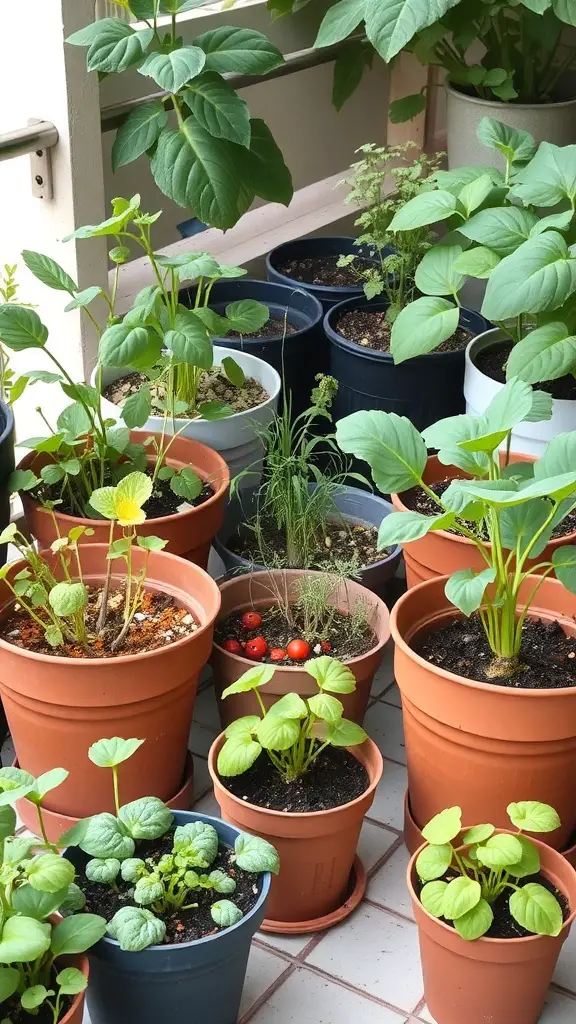
Creating a balcony vegetable garden is a fun way to enjoy fresh produce right at home. When space is tight, choosing the right vegetables is key to success. The image shows a vibrant collection of potted plants, showcasing a variety of vegetables that thrive in limited areas.
Start with compact plants like cherry tomatoes, which are perfect for pots and offer a rewarding harvest. Leafy greens like spinach and lettuce are also great choices. They grow quickly and can be harvested multiple times, making them ideal for small spaces.
Herbs like basil and parsley not only add flavor to your meals but also thrive in pots. They require minimal space and can be grown alongside other vegetables. Consider planting radishes, too; they grow fast and can be sown in small containers.
When planning your garden, think about the sunlight your balcony receives. Most vegetables need at least six hours of sunlight daily. Grouping plants with similar light and water needs can help keep your garden thriving.
Using vertical space can also maximize your garden. Hanging pots or wall planters can add more variety without taking up much room. With a little creativity, you can turn your balcony into a productive vegetable garden.
Companion Planting for Pest Control
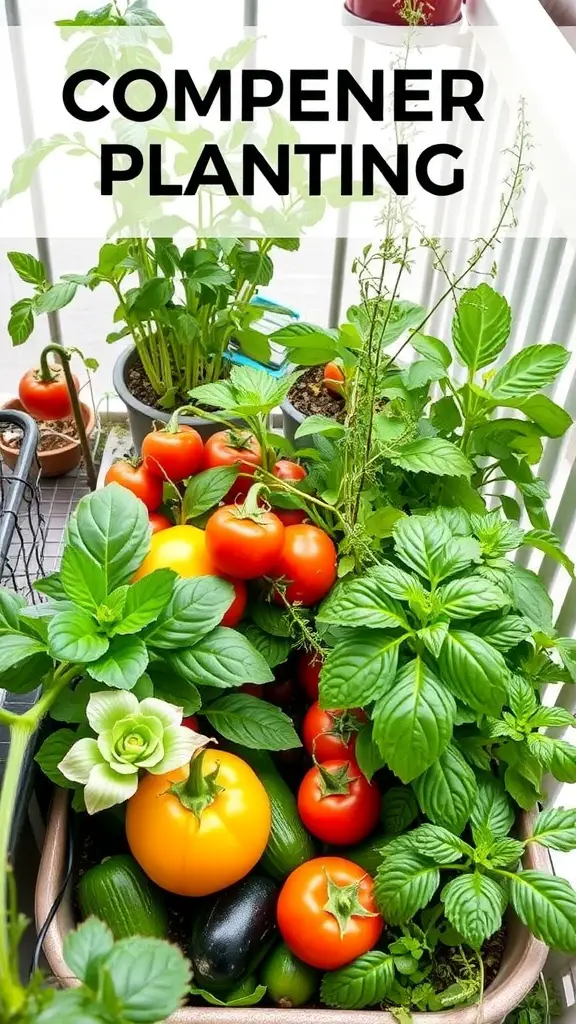
Companion planting is a fantastic way to keep pests at bay while maximizing your balcony vegetable garden’s potential. In the image, you can see a vibrant mix of plants, including tomatoes, zucchini, and herbs. These plants not only look great together but also work well in harmony.
For instance, tomatoes thrive when planted alongside basil. Basil helps repel pests like aphids and whiteflies, which can harm your tomatoes. Similarly, zucchini can benefit from being near marigolds, as these flowers deter squash bugs.
Creating a companion planting scheme is simple. Start by grouping plants that support each other. This method not only protects your veggies but also encourages healthy growth. Plus, it adds diversity to your garden, making it more resilient.
So, when planning your balcony garden, think about which plants can help each other out. It’s a natural way to keep your garden thriving and pest-free!
Vertical Gardening Techniques for Maximizing Space
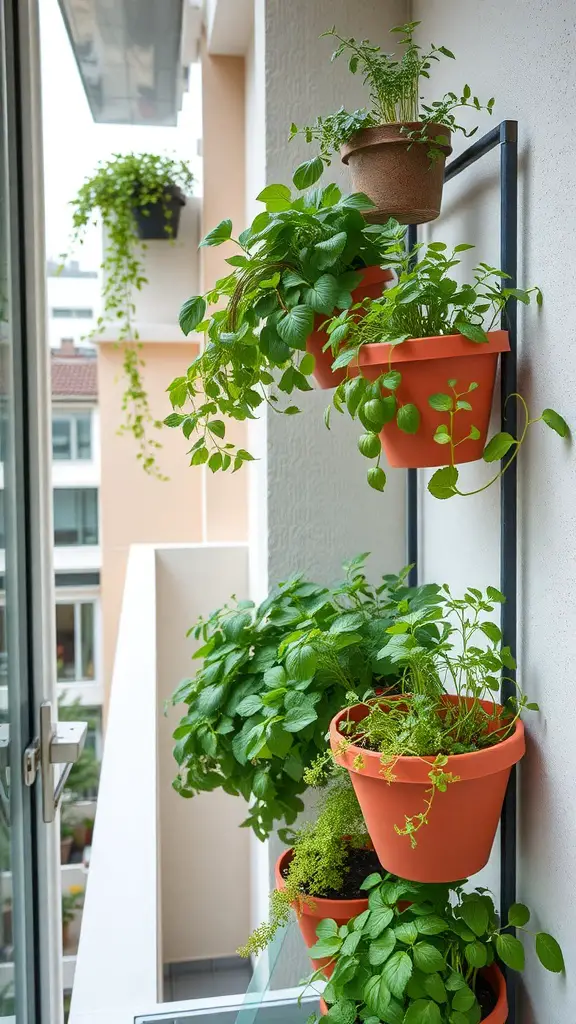
Vertical gardening is a fantastic way to make the most of limited space, especially on a balcony. In the image, you can see a variety of plants arranged in pots on a vertical structure. This setup not only saves space but also adds a touch of greenery to your living area.
The plants are thriving, showing how effective vertical gardening can be. By stacking pots, you can grow multiple herbs and vegetables in a small footprint. This method allows for better air circulation and sunlight exposure, which are essential for healthy growth.
Using different pot sizes and types can create an appealing visual effect. You can mix herbs like basil and mint with leafy greens, making your balcony both functional and beautiful. Plus, having fresh herbs at your fingertips is a great bonus for cooking!
To start your own vertical garden, consider using wall-mounted planters or shelves. You can even repurpose old pallets or crates for a rustic look. Just ensure that your plants get enough sunlight and water. With a little creativity, your balcony can become a lush garden oasis.
Using Edible Flowers in a Vegetable Garden
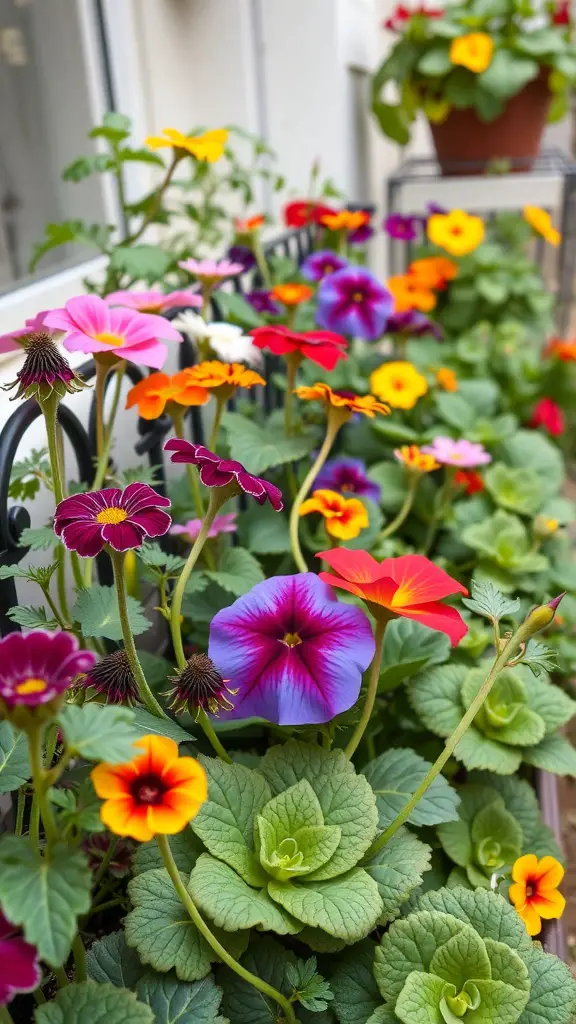
Edible flowers can bring a splash of color and flavor to your balcony vegetable garden. Imagine vibrant blooms nestled among your veggies, creating a lively and inviting space. The image showcases a delightful array of flowers, each adding beauty and potential culinary uses.
Flowers like nasturtiums, pansies, and violas not only look stunning but also enhance your dishes. Nasturtiums have a peppery taste, perfect for salads, while pansies and violas add a sweet touch. These blooms can be used to garnish plates or even infused into drinks for a unique twist.
Incorporating these flowers is simple. Just plant them alongside your vegetables. They attract beneficial insects and can deter pests, making your garden healthier. Plus, they’re easy to grow in pots or garden beds, fitting perfectly into any balcony setup.
When harvesting, make sure to pick flowers that haven’t been treated with pesticides. Rinse them gently and enjoy their fresh flavors. Edible flowers not only elevate your meals but also create a beautiful, thriving garden space.
DIY Trellis Ideas for Climbing Vegetables
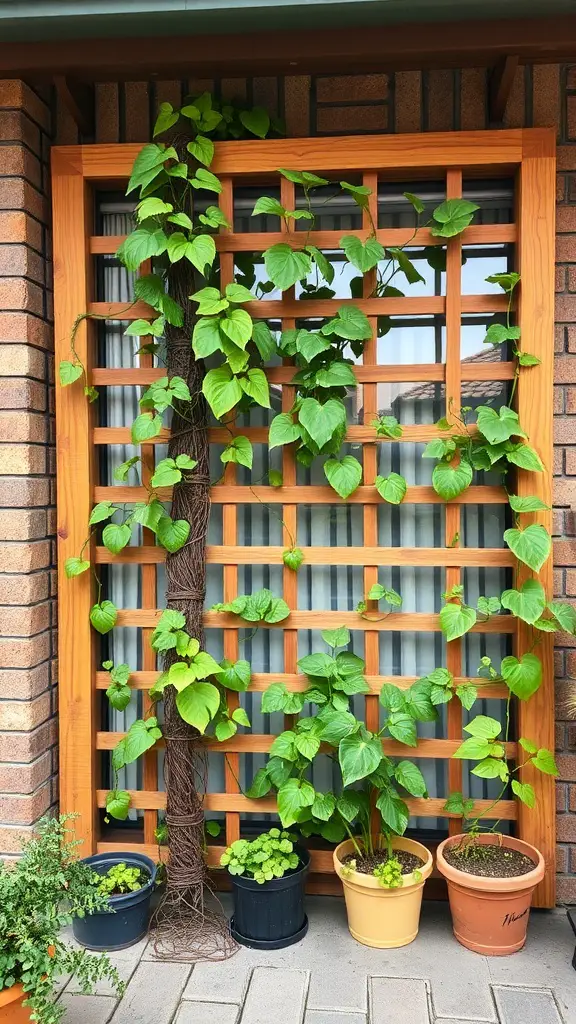
A trellis can be a fantastic addition to your balcony vegetable garden. It not only saves space but also adds a touch of charm. In the image, you can see a beautifully crafted wooden trellis, which supports climbing plants. The vibrant green leaves create a lively atmosphere, making the space feel fresh and inviting.
Using a trellis allows plants like beans, peas, and cucumbers to grow upwards. This method helps maximize your growing area. The trellis in the image is designed with a sturdy frame, giving the plants something to cling to as they reach for the sky.
Consider using materials like wood or metal for your own trellis. You can even repurpose old furniture or pallets. Adding some pots at the base, as shown, can create a layered look. This not only enhances the visual appeal but also provides additional growing space for herbs or smaller plants.
Herb Gardening on a Balcony

Growing herbs on your balcony is a fun and rewarding way to add fresh flavors to your meals. The image shows a vibrant collection of herbs in pots, showcasing a variety of green leaves and healthy plants. This setup not only looks great but also provides easy access to fresh ingredients right outside your door.
Herbs like mint, basil, and thyme thrive in pots and can be grown in limited space. You can mix and match different herbs to create a mini herb garden. Just make sure they get enough sunlight and water, and you’ll be on your way to a flourishing balcony garden.
Using pots allows you to control the soil quality and drainage, which is key for healthy growth. Plus, it’s easy to rearrange them to catch the best sunlight throughout the day. With a little care, your balcony can become a green oasis filled with aromatic herbs.
Creating a Microclimate for Sensitive Plants
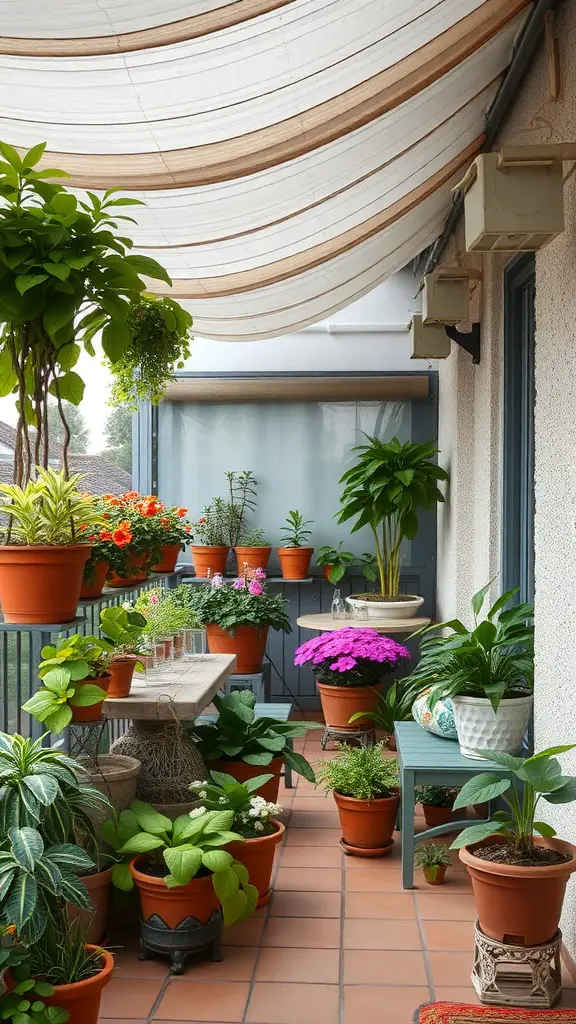
Creating a microclimate on your balcony can make a big difference for your vegetable garden. The image shows a vibrant balcony filled with various plants in pots. The arrangement of plants, along with the shade from the overhead covering, helps protect sensitive plants from harsh weather.
Using pots of different sizes allows for better air circulation and drainage. This setup can help maintain a stable temperature, which is essential for delicate plants. The colorful flowers and lush greenery not only look beautiful but also contribute to a healthy growing environment.
Consider placing taller plants at the back and shorter ones in front to maximize sunlight exposure. This way, all your plants can thrive. Adding a few herbs can also enhance the microclimate, as they can attract beneficial insects.
With the right care and attention, your balcony can become a thriving space for growing vegetables and herbs. Enjoy the process of nurturing your plants and watching them flourish!
Harvesting Techniques for Small Spaces

Harvesting from a balcony vegetable garden can be a rewarding experience. In the image, we see a person surrounded by lush greenery, holding a basket filled with fresh produce. This scene perfectly captures the essence of urban gardening.
When it comes to small spaces, timing is everything. Picking vegetables at their peak ripeness ensures the best flavor. Look for vibrant colors and firm textures as signs that your veggies are ready to go.
Using the right tools can make harvesting easier. A simple pair of garden scissors or a small knife works wonders. Gently cut the vegetables from their stems, taking care not to damage the plant. This encourages further growth.
Don’t forget to check for any hidden gems among the leaves. Some vegetables, like radishes and carrots, grow underground, so a little digging might be necessary. Always be gentle to avoid disturbing the surrounding plants.
Lastly, enjoy the process! Harvesting is not just about collecting food; it’s a chance to connect with your garden. Take a moment to appreciate the hard work that went into growing your veggies.
Pest Management Techniques for Small Gardens
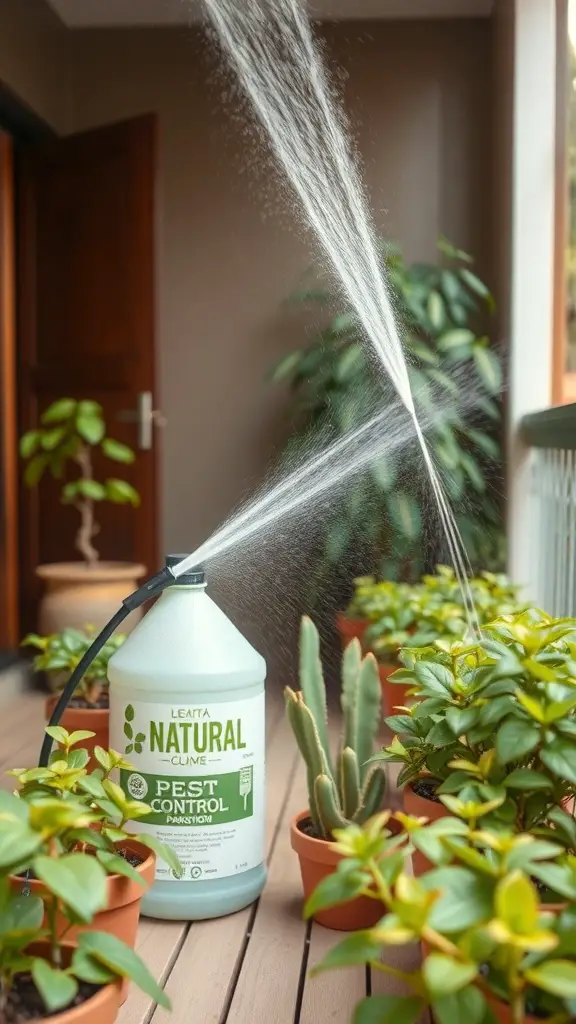
Managing pests in a small balcony vegetable garden can feel overwhelming, but it doesn’t have to be. The image shows a natural pest control solution being applied to a variety of plants. This approach is safe for both your veggies and the environment.
Using natural pest control methods, like the one in the photo, can help keep your plants healthy. It’s essential to regularly check your plants for signs of pests. Early detection makes it easier to manage any issues.
Another effective technique is to encourage beneficial insects. Ladybugs and lacewings can help control pest populations naturally. Planting flowers that attract these helpful bugs can create a balanced ecosystem right on your balcony.
Lastly, maintaining good plant hygiene is key. Remove any dead leaves and debris that can harbor pests. Keeping your garden clean not only looks good but also helps prevent infestations.
Balcony Garden Aesthetics and Design
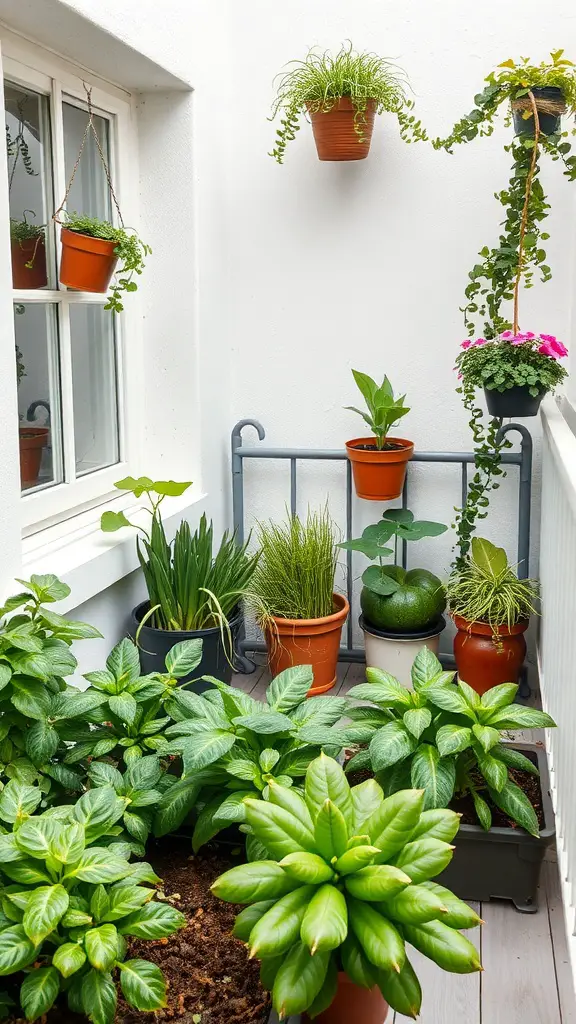
A balcony vegetable garden can be a delightful addition to your home. This image showcases a compact yet vibrant space filled with various plants. The arrangement is both functional and visually appealing, making the most of limited space.
The plants are neatly organized in pots, with some hanging from the wall. This design choice not only saves space but also adds layers to the garden, creating a lush atmosphere. The green leaves and colorful flowers bring life to the balcony, making it a perfect spot for relaxation.
Incorporating different heights and types of plants can enhance the overall look. The mix of leafy greens and flowering plants creates a beautiful contrast. This setup encourages a sense of tranquility, inviting you to enjoy your little green retreat.
Overall, a well-designed balcony garden can transform a simple outdoor area into a charming escape. It’s a wonderful way to connect with nature, even in an urban setting.




